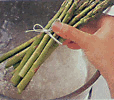Selection and storage
Asparagus spears are also known by many local names as Spragel, Spargelkraut, Asperges, Asperge Commune, Espárragos, etc.
While one may encounter asparagus year-round in supermarkets, its peak flavor is during springtime. In Europe, its shoots are available in shops from December to June.
Asparagus should be utilized promptly after harvesting to preserve its sweetness, as most of its sugar converts into starch over time. Opting to purchase from local farms or farmers’ markets ensures freshness.
When selecting from the markets, opt for tender, firm, straight, smooth, uniformly-sized, dark green/purple stalks with tightly closed tips. Avoid thick stalks with broad ridges, sunken areas, or dull colors, as they indicate older stock and may be off-flavored.
Due to their perishable nature, asparagus should be harvested in the morning when the weather is cooler. After picking, immerse the spears in ice-cold water to remove heat, drain, and store them in plastic bags in the refrigerator set between 38 to 40 degrees F with 90% to 95% relative humidity. Higher temperatures can cause the spears to lose natural sugars and vitamin C, resulting in a loss of flavor, increased toughness, and decay.
Preparation and serving methods
 |
 |
| The spears will snap where any woodiness begins. (Photo courtesy: The essential vegetarian cookbook). | Tie spears into a bundle. Cook for 2-3 minutes in boiling water with tips upward. Then just dip the tips briefly into the boiling water. |
Asparagus shoots are highly prized vegetables, especially during the spring season.
When cooking with fresh spears, it’s preferable to wash them under cool running water with a gentle scrub. Tender, pencil-thin spears can be cooked as is, while thicker stalks should be peeled before use in recipes.
Typically, asparagus spears require only brief cooking. Some households use traditional pots, immersing the stalks in boiling water while allowing the tips to steam cook.
Here are some serving suggestions:
 |
| Bruschetta with asparagus, tomato, and cheese toppings. Photo courtesy: rizkapb |
-
Asparagus spears can be enjoyed raw, steamed, sautéed, stir-fried, or mixed with vegetables, beans, poultry, or seafood.
-
Steamed spears served with citrus hollandaise sauce, melted butter, parmesan, or pecorino cheese make beautiful French-style recipes.
-
Grilled spring onions and asparagus stalks, coated with macadamia nut oil, create a mouth-watering appetizer.
-
Stir-fry tender shoots with sesame seeds, and season with garlic, ginger, and pepper paste.
-
Many restaurants in Germany offer special spargel menus during the spring season.
Safety Profile
Overall, asparagus is well tolerated, and allergic reactions are relatively rare.
Ingestion of young shoots may cause an offensive smell in the urine. This is due to the metabolism of asparagusic acid, which breaks down into various sulfur-containing degradation products such as methanethiol, sulfides, etc. However, this condition is harmless. (Medical disclaimer).
≻≻- Back to Vegetables from Asparagus. Visit here for an impressive list of vegetables with complete illustrations of their nutrition facts and
health benefits.
≻≻- Back to Home page.
Further reading:
-
Vegetable research and information center, University of California. (pdf-Link opens in new window).

